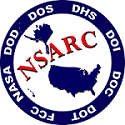National Search And Rescue Committee
Office of Search & Rescue (CG-SAR-2) | NSARC | Amver | Amver Blog | USCG RCCs | SAR Links |
 The NSARC is a coordinating and deliberative body of Federal agency representatives that share a common interest for the national improvement of civil search and rescue policy, procedures, effectiveness, and standardization. The purpose of the Committee is to coordinate and provide guidance for the implementation of the National SAR Plan (NSP).
The NSARC is a coordinating and deliberative body of Federal agency representatives that share a common interest for the national improvement of civil search and rescue policy, procedures, effectiveness, and standardization. The purpose of the Committee is to coordinate and provide guidance for the implementation of the National SAR Plan (NSP).
During the National Search and Rescue Conference of 1973, conference participants recognized the administrative void and concluded that a permanent committee needed to be established in order to oversee the administrative safeguarding of the United States National Search and Rescue Plan and to act as a coordinating medium for discussions involving national SAR related matters. Acting upon the Conference conclusion, the Secretary of Transportation, under DOT order 1120.28 dated 21 May 1974, established through a written inter-agency agreement the Interagency Committee on Search and Rescue (ICSAR) which was charged to carry out the aforementioned functions. The title name given to the inter-agency committee remained in effect from 1974 until a 1999 revision to the inter-agency cooperation agreement changed the committee’s title name to the “National Search and Rescue Committee (NSARC)”.
2703 Martin Luther King Jr. Ave, SE * Washington DC 20593
Phone: (202) 372-2090 * Facsimile: (202) 372-8357*
Email NSARC Secretariat here